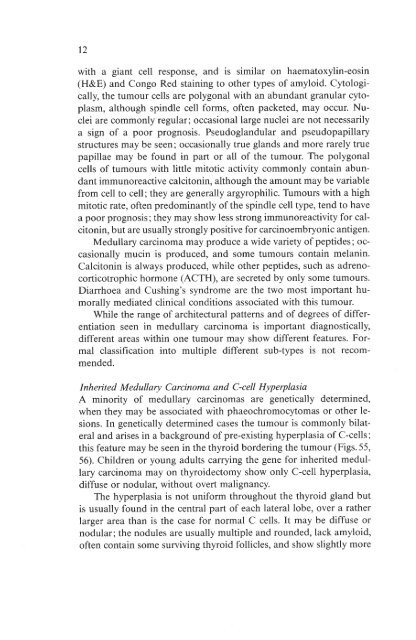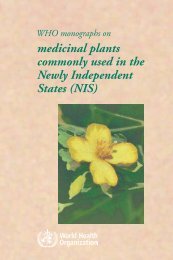Histological Typing of Thyroid Tumours - libdoc.who.int - World ...
Histological Typing of Thyroid Tumours - libdoc.who.int - World ...
Histological Typing of Thyroid Tumours - libdoc.who.int - World ...
Create successful ePaper yourself
Turn your PDF publications into a flip-book with our unique Google optimized e-Paper software.
72<br />
with a giant cell response, and is similar on haematoxylin-eosin<br />
(H&E) and Congo Red staining to other types <strong>of</strong> amyloid. Cytologically,<br />
the tumour cells are polygonal with an abundant granular cytoplasm,<br />
although spindle cell forms, <strong>of</strong>ten packeted, may occur. Nuclei<br />
are commonly regular; occasionalarge nuclei are not necessarily<br />
a sign <strong>of</strong> a poor prognosis. Pseudoglandular and pseudopapillary<br />
structures may be seen; occasionally true glands and more rarely true<br />
papillae may be found in part or all <strong>of</strong> the tumour. The polygonal<br />
cells <strong>of</strong> tumours with little mitotic activity commonly contain abundant<br />
immunoreactive calcitonin, although the amount may be variable<br />
from cell to cell; they are generally argyrophilic. <strong>Tumours</strong> with a high<br />
mitotic rate, <strong>of</strong>ten predominantly <strong>of</strong> the spindle cell type, tend to have<br />
a poor prognosis; they may show less strong immunoreactivity for calcitonin,<br />
but are usually strongly positive for carcinoembryonic antigen.<br />
Medullary carcinoma may produce a wide variety <strong>of</strong> peptides; occasionally<br />
mucin is produced, and some tumours contain melanin.<br />
Calcitonin is always produced, while other peptides, such as adrenocorticotrophic<br />
hormone (ACTH), are secreted by only some tumours.<br />
Diarrhoea and Cushing's syndrome are the two most important humorally<br />
mediated clinical conditions associated with this tumour.<br />
While the range <strong>of</strong> architectural patterns and <strong>of</strong> degrees <strong>of</strong> differentiation<br />
seen in medullary carcinoma is important diagnostically,<br />
different areas within one tumour may show different features. Formal<br />
classification <strong>int</strong>o multiple different sub-types is not recommended.<br />
Inheited Medullary Carcinoma and C-cell Hyperplasia<br />
A minority <strong>of</strong> medullary carcinomas are genetically determined,<br />
when they may be associated with phaeochromocytomas or other lesions.<br />
In genetically determined cases the tumour is commonly bilateral<br />
and arises in a background <strong>of</strong> pre-existing hyperplasia <strong>of</strong> C-cells;<br />
this feature may be seen in the thyroid bordering the tumour (Figs.55,<br />
56). Children or young adults carrying the gene for inherited medullary<br />
carcinoma may on thyroidectomy show only C-cell hyperplasia,<br />
diffuse or nodular, without overt malignancy.<br />
The hyperplasia is not uniform throughout the thyroid gland but<br />
is usually found in the central part <strong>of</strong> each lateral lobe, over a rather<br />
larger area than is the case for normal C cells. It may be diffuse or<br />
nodular;the nodules are usually multiple and rounded, Iack amyloid,<br />
<strong>of</strong>ten contain some surviving thyroid follicles, and show slightly more
















